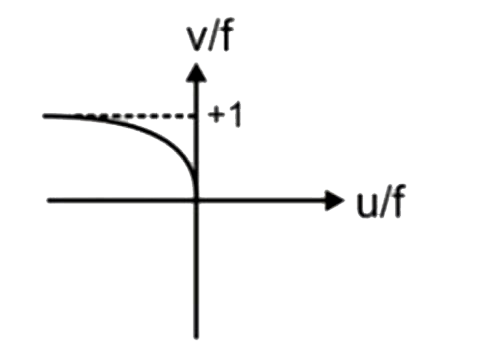A virtual erect image by a diverging lens is repesented by (u ,v ,f , are coordinates)




The correct Answer is:B
For vertical erect image by diverging lens.
u, v and f are negative
∴uf=+ve and vf=+ve
1f=1v−1u1=fv−fu1y=1x+1
y=xx+1 since x&y and +ve graph lies in firstt quadrant. Also, at x=0,y=0 and at x=∞,,y=1 Hence, (D)
Topper's Solved these Questions
- GEOMATRICAL OPTICS BOOK - RESONANCECHAPTER - GEOMATRICAL OPTICS EXERCISE - Exercise-2
63 Videos
- GEOMATRICAL OPTICS BOOK - RESONANCECHAPTER - GEOMATRICAL OPTICS EXERCISE - Exercise-3
79 Videos
- GEOMATRICAL OPTICS BOOK - RESONANCECHAPTER - GEOMATRICAL OPTICS EXERCISE - Problem
33 Videos
- EXPERIMENTAL PHYSICSBOOK - RESONANCECHAPTER - EXPERIMENTAL PHYSICSEXERCISE - PART -II
10 Videos
- GRAVITATIONBOOK - RESONANCECHAPTER - GRAVITATIONEXERCISE - HIGH LEVEL PROBLEMS
16 Videos
Similar Questions
Virtual images are formed by diverging rays.
View SolutionA Galilean telescope obtains the erect final image by using a diverging lens of focal length 7.5 cm instead of an intermediate erecting lens. If the focal length of the objective is 150 cm, what is the separation between the objective and the eyepiece?
View Solution
Knowledge Check
Erect image by convex lens is always
Asame sizeBmagnifiedCdiminishedDnone of theseA real inverted image in a concave mirror is represented by (u,v, f are corrdinates)
A B
B C
C D
D
Assertion (A) : A convex lens is called a convergent lens but a concave lens acts as a divergent lens.
Reason (R) : A convergent lens is that which always forms a real image of a real object and a divergent lens is that which can never form a real image.ABoth (A) and (R) are true and (R) is correct explanation of the assertion.BBoth (A) and (R) are true but (R) is not the correct explanation of the assertion.C(A) is true but (R) is false.D(A) is false but (R) is true.
If a virtual, erect and enlarged image is formed by a lens, then which of the following options are correct?
View Solutiona) Construct ray diagrams to illustrate the formation of a virtual image using i) a converging lens, and ii) a diverging lens.
b) What is the difference between the two images formed above?
View SolutionWhich of the following form(s) a virtual and erect image for all positions of the object?
(1) Convex lens
(2) Concave lens
(3) Convex mirror
(4) Concave mirror
View SolutionA 50 cm tall object is at a very large distance from a diverging lens. A virtual, erect and diminished image of the object is formed at a distance of 20 cm in front of the lens. How much is the focal length of the lens?
View SolutionAssertion :- The minimum distance between a real object and its real image formed by a convex lens is 4f.
Reason :- Convex mirror and concave lens form a virtual and erect image for all positions of the real object.
View Solution
